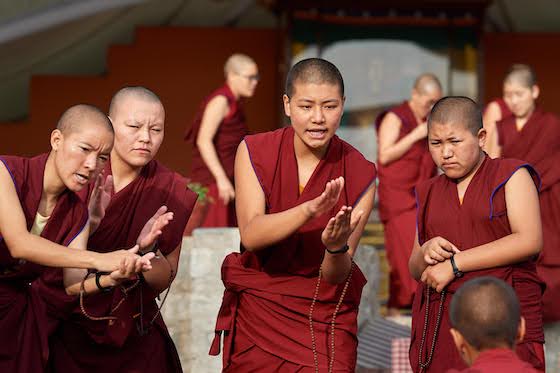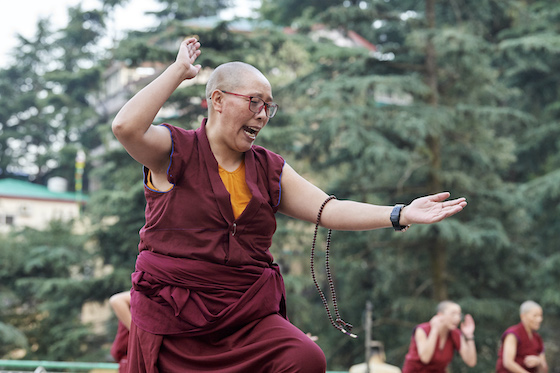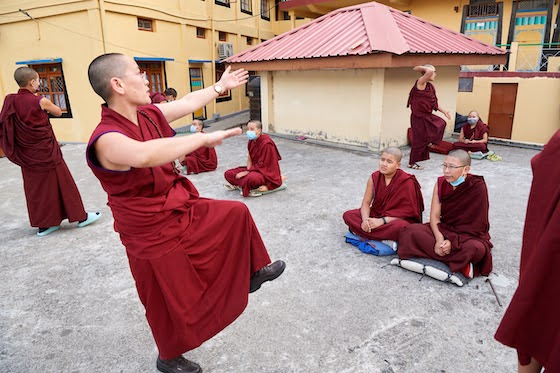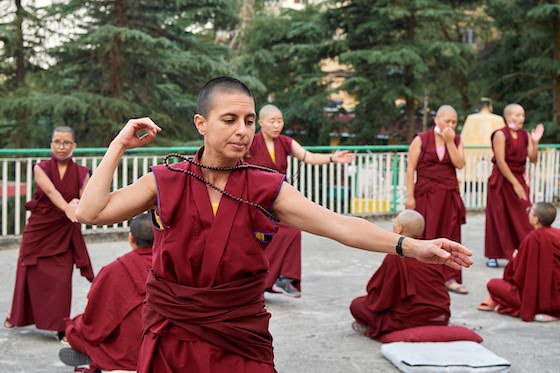Watching nuns or monks practice debate is fascinating because of their lively hand and body motions, but many observers wonder about the meaning of the gestures in Tibetan Buddhist debate.

A group of nuns act as Challengers and pose questions to seated nuns during daily debate practice at Dolma Ling Nunnery and Institute. Debate in Tibetan Buddhism serves many purposes including clearing up doubts, developing critical thinking skills, deepening one’s understanding of Tibetan Buddhist philosophy, and increasing wisdom and compassion. Photo courtesy of Olivier Adam.
Monastic debate is noisy. When you see Tibetan debating for the first time, the debaters’ stances, gestures, and sounds may seem confrontational. Yet everyone practices debate with an attitude of respect and a shared desire to deeply understand the Buddhist teachings.
Each hand and body motion is rooted in wisdom and compassion, which must be united to attain enlightenment.
The Meaning of Gestures in Tibetan Buddhist Debate
Daily practice in monastic debate is of critical importance in traditional Tibetan Buddhist learning. Through debate, nuns and monks test and consolidate their classroom learning and gain a thorough understanding of the Buddhist teachings.
In daily debate practice, the Challenger chooses the topic from the Buddhist philosophical texts studied earlier that day. The Challenger stands and asks questions to the Defender who is seated and who must answer. Sometimes monastics debate in groups. There is strength is numbers and the weak learn from the strong.
As the Challenger asks the question, she or he claps loudly to punctuate the end of the question.
In the gestures of debate, the right hand represents compassion or method. The left hand represents wisdom. The loud clap signifies the joining of wisdom and compassion.

A Tibetan Buddhist nun practicing debate dramatically claps her hands together after asking her question. The loud clap signifies the coming together of compassion (right hand) and wisdom (left hand). Photo by Olivier Adam taken at Geden Choeling Nunnery in Dharamsala, India.
When the Challenger claps her hands together, she simultaneously stomps her left foot. This symbolizes the slamming of the door to rebirth in the lower realms.
After the clap and stomp, the Challenger holds out her left arm which represents wisdom. Through this motion, she represents keeping the door to all rebirth shut.

Stomping one’s foot in Tibetan monastic debate symbolizes slamming of the door to rebirth in the lower realms. Photo by Olivier Adam of a nun practicing daily debate at Geden Choeling Nunnery.
Then she uses her right arm to lift up her mala (Tibetan prayer beads) around her left arm. This gesture represents the compassionate lifting up of all suffering beings from the cycle of rebirth.
As His Holiness the Dalai Lama has said, “The root of suffering is the unruly mind, so the practice of Dharma is to transform the mind.” The practice of debate helps develop critical thinking skills, deepens one’s understanding of Tibetan Buddhist philosophy, and increases wisdom and compassion.
If the Defender’s answer is satisfactory, the Challenger moves on to the next question. If not, the Challenger will make a gesture like an alligator closing its jaws, loudly smacking her hands together as she seeks an in-depth explanation from the Defender.

A nun uses her right arm to lift up her mala or Tibetan prayer beads around her left arm. This gesture represents the compassionate lifting up of all suffering beings from the cycle of rebirth. Photo by Olivier Adam.
The Importance of Tibetan Buddhist Debate
The following video is a great primer on debate by Tibetan Buddhist nuns. It is part of a longer video made by the nuns at Dolma Ling Nunnery and Institute in northern India. It answers many questions about monastic debate and shows and describes the gestures.
Can’t see the video? Click here.
“The logic and epistemology that prevailed in ancient India have lapsed in modern times, but we Tibetans kept them alive in our monasteries,” said His Holiness the Dalai Lama at an important debate event in India. “Our studies are rigorous. We memorize texts word by word, study commentaries to them and engage in debate during which we refute others’ positions, assert our own and rebut criticism.”
Debate pushes everyone to study and to try to understand the meaning of the texts.
Training Nuns in Debate
Traditionally, Buddhist nuns have not had the same access to education as monks. This is true also for training in monastic debate. The Tibetan Nuns Project’s mission is to educate and empower nuns of the Tibetan Buddhist tradition as teachers and leaders, and to establish, strengthen, and support educational institutions to sustain Tibetan religion and culture.
Now nuns are able to get training and daily practice in monastic debate. In addition to their regular daily debate practice at their own nunneries, each year hundreds of Tibetan Buddhist nuns from nunneries in India and Nepal gather for a special, month-long inter-nunnery debate called the Jang Gonchoe.
Here is a video of the 2019 Jang Gonchoe inter-nunnery debate. Can’t see it? Click here.
Before 1995, there was no Jang Gonchoe for nuns and this learning opportunity was only open to monks. The Tibetan Nuns Project, with the wonderful support of our patron, His Holiness the Dalai Lama, played a critical role in opening up this learning opportunity to women. Establishing a comparable debate session for nuns has been an integral part of the nuns reaching their current level of excellence in their studies.
The inter-nunnery debate helps bring the nuns closer to equality with the monks in terms of learning opportunities and advancement along the spiritual path. For many, the Jang Gonchoe is an essential component of working towards higher academic degrees, such as the Geshema degree, equivalent to a doctorate in Tibetan Buddhism.
His Holiness the Dalai Lama has said, “Nowadays, the Nalanda tradition of approaching the Buddha’s teachings with logic and reason is only found amongst Tibetans. It’s something precious we can be proud of and should strive to preserve.”

Tibetan debate gestures explained.